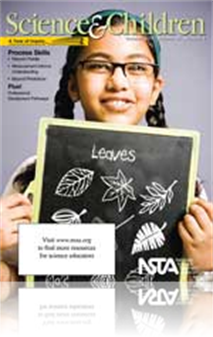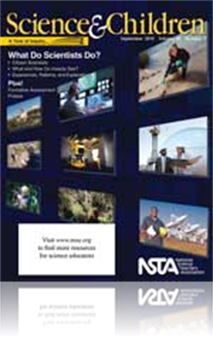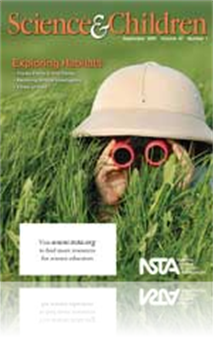All Science and Children resources
Journal Article
Every Day Science Calendar: October 2010
This monthly feature contains facts and challenges for the science explorer....
Journal Article
The setting: the science classroom. The characters: you and your students. The scene: Your students acting out scientific discoveries, modeling a frog’s life cycle, mimicking the transition from liquid to solid. This is dramatic science, a teaching...
Journal Article
Flower petals, acorn hats, exoskeletons of beetles, and lichens are just a few of the objects students may find in a surprising array of vivid colors. These tiny examples from nature’s palette can be discovered in a school yard, a park, or even alo...
Journal Article
NSTA initiated the student chapter program in 2001 to help preservice science teachers at universities and colleges gain access to professional development opportunities and provide support as they enter the profession. Here the authors share example...
Journal Article
Science 101: What and how do insects see?
Insect vision is both simple and complex. It’s simple in that insects can’t focus and generally see a blur. It’s complex in that insects are very good at detecting motion, they can see in almost any direction, they can use polarized ultraviolet...
Journal Article
Insect vision is an area of active research that allows fruitful exploration into the nature of the scientific endeavor because of the bias our own vision brings. As scientists, we use our senses to make observations, but we can’t assume that what ...
Journal Article
Message from the NSTA President: Imagine and Invent—Create a Great Future
The time is right for an emphasis on imagination and innovativeness in science education, both in students and in teachers. Change now dominates our economy and culture, and can only be realized through imagination and creativeness. Therefore, our ne...
Journal Article
The Early Years: Inquiry at Play
Play and science inquiry are essential parts of early childhood programs. Imaginative play, unscripted yet guided by children’s own rules, allows students to use their imagination and develop self-regulation, symbolic thinking, memory, language, an...
Journal Article
Thinking Like a Ssssscientist!
A fear of snakes developed into an opportunity to teach students about the process of science: formulating questions, collecting and analyzing data, and communicating findings to the public. By using snakes to help students “think like a scientist,...
Journal Article
In this article, a science teacher from the Midwest reflects on her summer vacation to the Gulf of Mexico. She felt that this vacation would help improve her teaching about the environmental problems in the gulf and elsewhere. After all, anyone can s...
Journal Article
Formative Assessment Probes: “Doing” Science
The “Doing Science” probe from Uncovering Student Ideas in Science: Another 25 Formative Assessment Probes (Keeley, Eberle, and Dorsey 2008) can reveal some surprising ideas your students have about how scientists do their work. In order to build...
Journal Article
Guest Editorial: A Powerful Way to Learn
If our classroom instruction is to truly reflect what scientists do, it is important to put students in situations in which they are expected to ask questions about the natural world, design investigations to answer these questions, collect data, and...
Journal Article
Method and Strategies: Supporting Ideas With Evidence
One way to help elementary students see connections more easily and to make their thinking more visible is to teach them to approach scientific investigation and problem solving as scientists do—from the framework of “finding evidence to support ...
Journal Article
How can a teacher simultaneously teach science concepts through inquiry while helping students learn about the nature of science? After pondering this question in their own teaching, the authors developed a 5E learning cycle lesson (Bybee et al. 2006...
Journal Article
Every Day Science Calendar: September 2010
This monthly feature contains facts and challenges for the science explorer....





